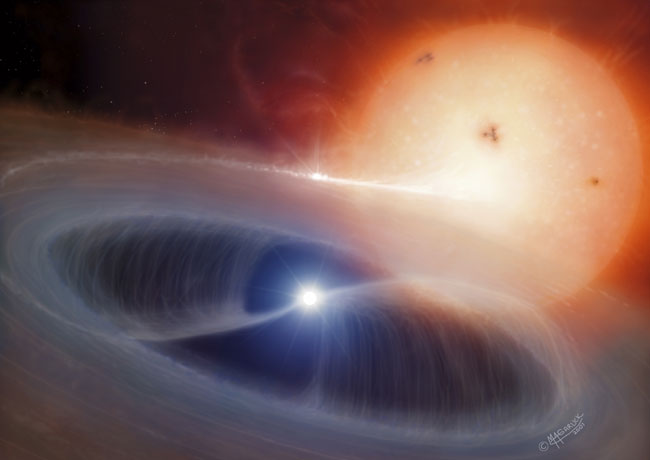Credit & Copyright: Mark Garlick
(Space-art)
Explanation:
How can two stars create such a strange and intricate structure?
Most stars are members of
multiple-star systems.
Some stars are members of close
binary systems
where material from one star swirls around the other in an
accretion disk.
Only a handful of stars, however, are members of an
intermediate polar, a system featuring a
white dwarf star with a
magnetic field that significantly pushes out the inner
accretion disk,
only allowing material to fall down its magnetic poles.
Shown above is an artist's depiction of an
intermediate
polar system, also known as a
DQ Hercules system.
The foreground white dwarf is so close to the normal star that it
strips away its outer atmosphere.
As the white dwarf spins, the columns of infalling gas rotate with it.
The name
intermediate polar derives from observations of emitted light
polarized
at a level intermediate to non-disk binary systems known as
polars.
Intermediate
polars
are a type of
cataclysmic variable star system.
1999 2000 2001 2002 2003 2004 2005 2006 2007 2008 2009 2010 2011 2012 2013 2014 2015 2016 2017 2018 2019 2020 2021 2022 2023 2024 2025 |
Yanvar' Fevral' Mart Aprel' Mai Iyun' Iyul' Avgust Sentyabr' Oktyabr' Noyabr' Dekabr' |
NASA Web Site Statements, Warnings, and Disclaimers
NASA Official: Jay Norris. Specific rights apply.
A service of: LHEA at NASA / GSFC
& Michigan Tech. U.
|
Publikacii s klyuchevymi slovami:
binary star - dvoinye sistemy - polyary
Publikacii so slovami: binary star - dvoinye sistemy - polyary | |
Sm. takzhe:
Vse publikacii na tu zhe temu >> | |
